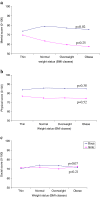Effect of gender on the association between weight status and health-related quality of life in adolescents
- PMID: 23157722
- PMCID: PMC3524037
- DOI: 10.1186/1471-2458-12-997
Effect of gender on the association between weight status and health-related quality of life in adolescents
Abstract
Background: Some studies have investigated the association between body mass index (BMI) and health-related quality of life (HRQoL) among adolescents, but their results have been discrepant and few paid attention to the role of gender. The present investigation aimed to assess the relationship between weight status and HRQoL in adolescents and to verify whether it was similar in boys and girls.
Methods: Five thousand two hundred and twenty six adolescents aged 14 to 18 years were included in the PRomotion de l'ALIMentation et de l'Activité Physique (PRALIMAP) trial, a 2x2x2 factorial cluster randomized trial performed in 24 high schools in France. Sociodemographic, anthropometric and HRQoL data were collected. BMI was categorized in four classes (thin, normal-weight, overweight, obese). Linear regression models were used to estimate the association between weight status and HRQoL, adjusting for confounders.
Results: The mean age of adolescents was 15.7±0.6 years and their mean BMI was 21.6 ±3.5 kg/m2; 55% were girls. Boys were more often overweight and obese than were girls (overweight: 15.6% vs 14.2%, obese: 4.8% vs 3.3%), and girls were more likely to be thin (5.5% vs 4.5%, p=0.0042). All HRQoL scores were higher for boys (p=<0.0001). Weight status was not associated with physical and social scores neither in boys nor in girls. Conversely, it was associated with mental score, but differently in girls than boys. As compared with normal-weight girls, thin girls had better mental HRQoL (β=+6.17, p=0.0010), and overweight and obese girls had lower mental HRQoL (β=-3.89 and β=-5.90, respectively, p<0.001). Mental HRQoL was lower for thin, overweight and obese boys than for normal-weight boys (β= -4.97, β= -1.68 and β= -3.17, respectively, p<0.0001).
Conclusions: Gender can modify the association between weight status and HRQoL in adolescents. Body image could be an important target of public health programs to improve subjective health during adolescence.
Figures

References
-
- Lobstein T, Baur L, Uauy R. Obesity in children and young people: a crisis in public health. Obes Rev. 2004;5(Suppl 1):4–104. - PubMed
-
- Kirchengast S. Gender Differences in Body Composition from Childhood to Old Age: An Evolutionary Point of View. J Life Sci. 2010;2:1–10.
-
- De Peretti C, Castetbon K. Surpoids et obésité chez les adolescents scolarisés en classe de troisième. Études et résultats. 2004;283:1–4.
Publication types
MeSH terms
LinkOut - more resources
Full Text Sources
Research Materials

